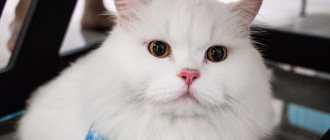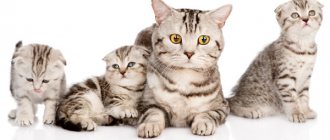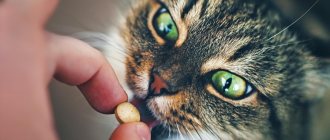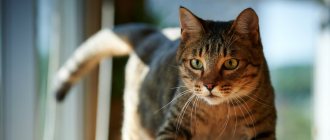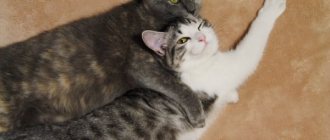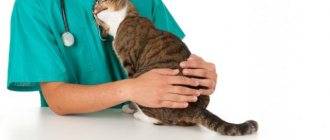Symptoms Causes Diagnosis Treatment. What to do if your cat has urinary incontinence? Bladder problems (urinary incontinence in cats) are usually caused by a weakened bladder or due to partial obstruction in the bladder. Owners of cats and cats may perceive this type of violation as spontaneous urination - that is, they may think that the cat deliberately leaves puddles in the wrong places. Urinary incontinence is more common in middle-aged, old, and large breed cats.
The cat stopped going to the litter box, what should I do?
Urinary incontinence in cats is divided into several types, according to the nature of the manifestations:
- The cat's urine is constantly flowing in small drops. The cause of this disease is a weakening of the muscles that control the sphincter. Another reason is weak bladder muscles that are unable to stretch and contract.
- The inability to tolerate is called urge incontinence. Urine excretion occurs spontaneously as soon as the pet feels the urge. Such animals do not have time to reach the tray, but strive towards it.
- Stress incontinence has nothing to do with psychological stress. This refers to a sharp increase in pressure in the abdominal cavity, which leads to urination. In such animals, discharge can occur, for example, from a sharp jump.
- Reflex discharge occurs when the pet does not feel the urge to pee. Emptying occurs reflexively.
- Nocturnal inability to hold urine, as the name suggests, occurs at night when the pet is sleeping and cannot control the urge to pee.
If there is any suspicion of a disease, the owner should contact a veterinarian.
How do you know if you have incontinence?
As with any other health problem, urinary incontinence is accompanied by a number of signs that make it unmistakable:
- Drops or wells of urine when the cat stands up
- Stomach and legs are wet
- Strong smell
- Urine residue in unusual places
- Dermatitis
- Skin inflammation or disease
- Swelling of the penis or vulva
Sometimes a cat will urinate out of the box to show that it is feeling some discomfort, such as when it is suffering from a urinary infection, for example. This is why it is important to distinguish these warnings from the indiscriminate , erratic and involuntary urination that characterizes urinary incontinence.
Causes of urinary incontinence
Neurogenic
Caused by a malfunction of the nervous system, which can occur from injuries, tumors and hernias in the spine or brain. Nerve endings are pinched or ruptured, so their conductivity is disrupted.
Structural anomalies
They can be congenital (hypoplasia, ectopia), acquired (urethral and bladder stones, formation of urethrovaginal fistulas, etc.).
Functional disorders
Occur due to diseases affecting the functions of the excretory system. So, with urinary tract infections, inflammation of the walls of the bladder and urethra occurs, so the contractile activity of the bladder is disrupted, it becomes hyperactive.
With stones, tumors of the bladder, kidneys, adrenal glands, acute urinary retention may occur in a cat. Cystitis and nephritis are also accompanied by urination problems.
Factors such as proper pet maintenance, feeding regimen, and lack of stress are very important. Too fatty or spicy foods make the urine more alkaline, which can lead to itching, burning of the urethra, and inflammation of the upper parts of the urinary system. Therefore, it is strictly forbidden to feed an animal with food from our table.
Stress and strong emotional tension
Cats are susceptible to stress caused by fear, excitement, jealousy, changes in their usual daily routine, trips to the veterinarian, or moving to a new place of residence. A strong emotional shock can cause unwanted behavior in an animal, in which it forgets its “toilet” skills and begins to shit anywhere, even on the owner’s bed. This is how the cat expresses its emotions and calls on its owner for help. It is impossible to strongly scold or physically punish a pet for this offense; on the contrary, you need to show maximum attention to it. We recommend showing more affection, care and communication to the animal in anticipation of possible stressful situations, which include:
- change of place of residence;
- traveling by car or public transport;
- journey;
- arrival of guests;
- the appearance of a small child in the house;
- the appearance of another pet, etc.
If a puddle on the bed is caused by a stressful situation, it is important to prevent the animal’s unwanted behavior from becoming established.
Symptoms
With night incontinence, the pet wakes up “in a puddle”; with urgent incontinence, the pet does not have time to run to the litter box. Reflex voiding is the most noticeable: the animal can urinate anywhere at any time.
The owner needs to analyze the general condition of the animal, for example, lethargy, drowsiness, aggressiveness or irritability. Other behavioral disorders: anxiety, refusal to go to the litter box or, conversely, frequent visits to the toilet, also require attention. Pink urine in a cat, the presence of mucus and impurities in it, is an important “bell” to immediately consult a doctor. Do not try to treat the animal yourself. Only after a complete examination and passing all tests can treatment be prescribed.
Preventing FLUTD in your cat
After visiting your veterinarian, you can make changes in your pet's life to reduce the likelihood of a recurrence of urological syndrome. It has been proven that a change in environment, “cat house-fitting,” reduces the risk of relapse by 80% and can help your cat go to the litter box more often. Spend more time with your cat, give her access to windows, and give her more toys. It is also recommended to increase the number of trays in your home, as well as the litter in them, and make sure that they are always clean - cats love cleanliness!
_______________________________________________ 1 from English. Feline lower urinary tract disease 2 According to the International Society of Feline Medicine (ISFM) https://icatcare.org/advice/feline-lower-urinary-tract-disease-flutd
Examination by a veterinarian
The doctor needs to tell all the symptoms that the owner noticed. During the examination, the veterinarian will perform palpation, which can be used to identify large tumors and organ development abnormalities.
In case of incontinence and other urological disorders, a urine test will be prescribed, most often microscopy of the sediment will be required. Previously, we have already given a detailed explanation of a urine test for a cat. If necessary, ultrasound and x-rays are also performed.
Additional studies may be needed, such as a blood test, microflora culture, and analysis of renal epithelium in the cat’s urine.
Important: obvious neurogenic disorders such as injuries, tumors, spinal hernias, and urinary disorders are treated by eliminating these factors.
In cases of functional disorders, a complete and comprehensive examination cannot be avoided. Only a complete collection of all indicators will make it possible to correctly diagnose and correctly prescribe treatment.
During the examination, the veterinarian will recommend using special diapers for animals. There should always be a clean, absorbent diaper on the sleeping area. These care items are sold at any pet store.
Important: do not scold your pet for its inability to tolerate, do not punish it under any circumstances. A stressful situation will only harm the animal, but affection and care, on the contrary, will help cope with the disease.
We get tested
It is better to take any tests in the morning on an empty stomach. The only exceptions are emergency cases, if the pet suddenly becomes ill and needs emergency hospitalization.
Donating blood is easy: the veterinary nurse will find a vein and take a portion of blood without any problems.
Many owners are concerned about the question of how to collect urine from a cat for analysis. To do this, prepare a tray: remove the filling, wash it, and pour boiling water over it. There is no need to use aggressive detergents such as bleach. Even if the pet doesn’t like the empty tray, sooner or later he will go into it. Drain the liquid into a jar and take it to the clinic.
If your pet does not have time to reach the tray, put a diaper on it. Later, squeeze the diaper into a jar for analysis. But this option is not very good, since the composition of the diaper can change the composition of the urine.
Another option: go to the clinic. To take the test, the doctor will insert a catheter. Catheterization is not very comfortable for the furry patient, but is completely painless. The most accurate and pure material is considered to be obtained by a-puncture of the bladder. The needle is inserted through the abdomen into the bladder, then the required amount of liquid is sucked out. The procedure is easily tolerated by animals; anesthesia or freezing is not required.
The cat pees on the bed, what to do
There is no single algorithm of actions for weaning a cat from shitting on the bed. The first thing caring owners need to do is to try to find out the cause of the unwanted behavior and eliminate it immediately, including with the help of a veterinarian.
You cannot shout loudly or use physical punishment at the culprit of the stinking puddle - this will provoke unnecessary aggression and resentment. If your pet continues to pee on the bed, tell him not to do so in a stern voice.
Additionally, it is recommended to check the cleanliness of the tray, its correct location and the quality of the filler. Show maximum attention to your pet, let him feel your care. The problem of puddles on the bed disappears as quickly as it appears.
Urinary incontinence in cats: treatment
Treatment is prescribed by the doctor after a complete history collection. Based on the results of tests and studies, the veterinarian determines the exact cause of the disease. If the inability to endure is caused by trauma, then all efforts are directed towards treating the trauma. The same applies to hernias and tumors: by getting rid of them, it is most often possible to normalize urination. If spinal cord injuries cannot be completely cured, and the inability to control the desire to pee persists, palliative measures are prescribed: homeopathy, physiotherapy, massage, and the use of special rehabilitation means.
If a cat has bloody urine, what should owners do?
It is necessary to bring your pet to a veterinarian as soon as possible, since blood in the urine is a possible sign of many diseases:
- Infections of the genitourinary system. Treatment is usually medication. A course of antibiotics, immunomodulators, and vitamins will put your pet back on its feet and relieve problems with urination.
- Blood impurities in the analysis occur in the presence of stones in the kidneys and/or bladder. Only by curing urolithiasis (urolithiasis), and, if necessary, operating on the animal, can you get rid of blood impurities and incontinence.
- Structural anomalies are subject to surgery. For example, suturing a vesicovaginal fistula will prevent vaginal exudate from entering the urine, and vice versa. By isolating the bladder from the constant causative agent of inflammation, it will be possible to cope with incontinence.
Prevention of recurrence of incontinence in a pet is by maintaining a proper diet, hygiene and an anti-stress environment at home.
How to stop a cat from shitting in the wrong place
The easiest way to solve a cat litter problem is if it is related to the cat's complaints about the litter box. It will be more difficult to wean your pet from relieving itself wherever it pleases if the reasons for this behavior are stress or the state of its health.
Domestic situations
Having discovered that the cat has begun to leave puddles and piles throughout the apartment, you need, first of all, to think about whether he has any complaints about his individual toilet and about you personally. Maybe you don’t react when the animal meows, signaling that the tray is dirty - in this case, “gifts” cannot be avoided. Most cats are incredibly clean, and they will always prefer a neat corner in the apartment to an untidy, foul-smelling litter box. Perhaps a more thorough washing of the cat's box immediately after the pet has finished its intimate activities is the only thing it needs to avoid looking for an alternative location for the toilet.
It happens that the owner moves the tray to another place, but the pet is either not used to it yet, or he is not satisfied with the new secluded corner. Cats are quite sensitive to such a delicate issue as the administration of natural needs. In the wild, they try to do this with maximum secrecy, realizing that at such a moment they are helpless and have no opportunity to defend themselves or escape. In this regard, the tray should be placed where the animal can feel safe. In addition, you need to check if there are containers with strong-smelling chemicals near the cat litter box.
It happens that a cat persistently leaves its tracks in the same place - this way it can communicate that it has chosen a comfortable corner for itself. If you don't mind moving the tray there, meet your pet halfway. Otherwise, you can try to cheat - move the box to a place the cat likes, and then, gradually and little by little, move it in the direction of a more convenient, from your point of view, location in the apartment.
Cats often avoid going into the litter box if they have complaints about its shape or size, then the litter box will have to be replaced. The fact that the fluffy one is no longer satisfied with the tray should not be surprising. This usually happens when the owner loses sight of the fact that the cat is growing. An “enlarged” pet simply cannot turn around in the box it was accustomed to as a kitten. In addition, in cramped conditions, he has no room to maneuver to bury his excrement. In such cases, animals may begin to shit in the bathtub, mistaking it for a large tray. It is quite easy to wean your cat from relieving itself in the bathroom - you just need to fill it with some water and close the drain. However, this does not solve the problem as a whole. The tray will still have to be replaced.
What kind of starship is this?! I'm better off in the boot.
If the new toilet will be in the form of a box with a door, it is better not to install a roof right away. The cat must first get used to this place.
A cat that continues to poop in the wrong place, despite purchasing a new litter box, may not be happy with its contents. It happens that the owner changed the clumping litter to wood, mineral to silica gel, or vice versa, and the animal protests against these innovations. Then you need to return to the filler that previously satisfied the pet. It happens that a cat, after spending a “vacation” at the dacha, has radically changed his preferences, and now he needs sand. Offer your animal all options, including torn newspapers. It may also turn out that he does not need any filler at all.
Competition
If several cats live in the house, intrigue can develop around the litter box. The fact is that kitties tend to quietly observe such an important object as an individual toilet. Knowing about this feature of their relatives, the most timid of pets may be embarrassed to carry out a scrupulous procedure under the supposed watchful supervision. He will prefer to find a more secretive corner in the apartment for this.
To make all cats comfortable, each of them needs to be provided with its own tray. It would be even better if they had an additional box - an “alternate airfield” for an “emergency landing.” The ideal way out is to place individual trays in separate corners, if living conditions allow this.
Stress
Cats may start pooping in inappropriate places as a result of stress. This happens if the emotional background in the house changes or the apartment is shaken by loud sounds and vibrations emanating from neighbors who have begun renovations. Cats do not tolerate moving well; after traveling, they may not go to the toilet for a couple of days at all, and you will look in vain for traces of the “crime” in different parts of the apartment. The appearance of a new family member or guests can throw an animal out of balance. In this case, the cat’s dissatisfaction intensifies due to the appearance of foreign odors. He, of course, will try to kill them with his “incense.”
If the cat refuses the tray in such situations, you need to be patient, do not scold him, and pet him more often. In most cases, over time, the fluffy returns to its usual place on its own, but you can try to “drive” it into the tray as quickly as possible.
Having traced where the cat has moved to secretly relieve itself, treat this place with a disinfectant. Today, any pet store sells specialized aromatic compositions in the form of sprays to repel pets from places inappropriate for the toilet.
Beaphar Stop it Cat Spray
The following drugs have proven themselves well:
- spray “Shit? No” (contains castor and essential oils, wormwood extract);
- spray “AntiGadin” (contains extracts of pepper, menthol, catechin);
- Beaphar Stop it Cat Spray (with natural ingredients that contain scents that repel cats in their natural environment).
It is recommended to use sprays 1-2 times a day to treat areas where the cat shits regularly. Traces of puddles and heaps should be destroyed very carefully so that no smell remains in these places, otherwise the ugly thing will return here. Not every drug will repel your pet, so you may have to experiment.
You can also purchase a special flashlight at a pet store. The gadget will come in handy if you can’t find the place where your cat gets into the habit of going to the toilet.
If you do not want to use chemicals, turn to traditional methods of keeping your apartment clean. Place orange or lemon peels and garlic cloves in the corner soiled by the cat - the animal will not like their inherent smell. Vinegar is a bad help in this case; it will only enhance the “aroma” of urine, and the cat will happily continue to use this place as a toilet. The same applies to bleach, which will also serve as bait.
You can also try placing a bowl of cat food in the place where the cat poops. He won't go to the bathroom where his food is.
If your pet does not return to the litter box for a long time, and its behavior is either too restless or, conversely, lethargic, you should contact a zoopsychologist. He will tell the owners how to find mutual understanding with the cat. In addition, special medications may be needed to reduce the animal’s stress level, and these should only be prescribed by a specialist.
Right here?
Diseases and age of the pet
Often the reason for a bad habit lies in the age of the cat. Aging purrs often suffer from diseases of the musculoskeletal system, anemia, and obesity. It becomes a problem for them to simply reach the place where the tray is located, and they arrange their toilet right next to the resting place. Or the poor thing still gets to it, but has difficulty climbing over the side. It’s easy to guess that a cat is having difficulty moving by watching how it overcomes obstacles: steps over a threshold or jumps onto an elevated surface.
In such a situation, you need to purchase a tray with the lowest sides and place it next to the cat's bed or in the corner where the animal spends most of its time. It is possible that you will have to move your pet into the tray in your arms.
Very often, cats suffering from diseases of the genitourinary system refuse to use the litter box. Pets experience pain when urinating, and they associate it with the litter box. It is not surprising that the animal begins to look for another place for its needs, leaving traces throughout the apartment. In this case, the only way out is to visit a veterinarian.
Sexual behavior and territorial disputes
During puberty, and then usually 3-4 times a year, representatives of the cat tribe begin to actively look for a mate. This is accompanied not only by heartbreaking screams, but also by marks. Fetid puddles appear on chairs, in the master's bed, in shoes and other places. At the same time, if the smell from the mark left by the cat is quite moderate, then the “aroma” that the cat’s wet footprints emit simply knocks you off your feet.
In addition, at any time of the year, cats can mark their territory with urine containing specific secretion products - pheromones. This process, similar to normal urination, is accompanied by a proud raising of the quivering tail, so that it is difficult to miss. However, it is impossible to prevent the inevitable “crime”. Everything happens very quickly, since the animal in such cases does not waste time to choose a place, sit down and bury its tracks. If there is a cat living in a neighbor's apartment, your pet will regularly leave its marks at the front door at the moment when a competitor begins to approach his door.
It is impossible to stop a cat from marking. Neither persuasion, nor threats, nor spraying your pet with a spray bottle, nor regularly cleaning up disgusting puddles will help. You can radically get rid of this problem only by sterilizing the animal. It is worth considering that after surgery, the pet may continue to mark its territory out of habit; this may be due to its individual characteristics. But in this case it becomes possible to wean him off.
People who, for various reasons, do not want to sterilize their pets often resort to hormonal drugs. With their help, you can also suppress the animal’s sexual instincts. But before offering the drug to your cat, you should consult a veterinarian.

